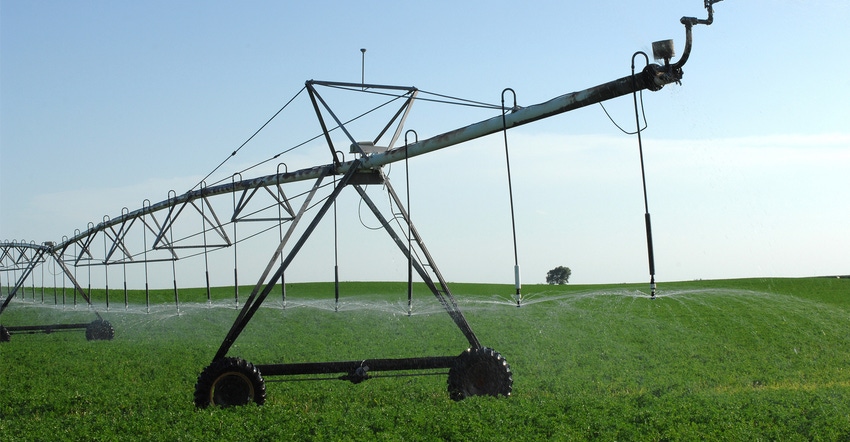
For generations, the Ogallala Aquifer has allowed agriculture to flourish in western Kansas. It is estimated that agricultural land values in Kansas are $3.79 billion higher today because of the aquifer supporting crop and livestock production.
Nathan Hendricks and Gabriel Sampson are Kansas State University agricultural economists who released the paper, “The Value of Groundwater in the High Plains Aquifer of Western Kansas,” Feb. 10. They used market values for irrigated and nonirrigated land, as well as aquifer levels, to reveal how much more value irrigation brings to land values in the West.
Land values
The average price of dryland is about $1,662 per acre, with irrigated ground valued 53% over that. When considering farmland, buyers look at the stock of groundwater under that irrigated parcel in their bids, according to Hendricks and Gabel.
“A potential buyer of farmland observes the quality of the land and the expected quantity of water available for present and future irrigation,” according to their paper. “All else equal, a 1-foot change in saturated thickness beneath the parcel can be inferred by buyers as a change in the productive quality of the parcel.”
It’s estimated for each additional 1 foot of saturated water thickness under a parcel of ground, it’s market value increases between $3.42 and $15.86 per acre.
Consider the 2.57 million irrigated acres over the Ogallala Aquifer just in Kansas, and that’s a total valuation — just on water reserves underground — of $8.79 million to $40.76 million for a uniform 1-foot increase in saturated thickness.
Effects of declining wells
As the aquifer depletes under an irrigation well, that well’s capacity also declines, according to the paper. Lower well capacities cost farmers in many ways:
higher energy costs and well upkeep to pump limited water from deeper underground
reduction of irrigated crop acres on a particular parcel
reduction of applied water, which could reduce crop yields
switch to less water-intensive crops
These can all result in reduced rental demand for a piece of irrigated land, which can then lead to reduced rental rates. Hendricks and Gabel explain that if the saturated thickness is initially less than 70 feet, if that decreases by 1 foot, the annual returns to the land over that part of the aquifer then drop by 23 cents per acre.
Meanwhile, if the saturated thickness is greater than 70 feet, that same drop of 1 foot of saturation just drops returns to that land by just a nickel per acre. That’s because when well capacity is large, a decrease isn’t felt as soundly as it is in a well with less capacity.
The economists give the example of Wichita County, Kan., with an average saturated thickness of less than 70 feet across the county. The county has roughly 460,000 acres over the aquifer, so a 1-foot decrease in saturated thickness would decrease returns to the land of about $104,400 in that one county.
Economic impacts
The study found that if no changes are made to how the aquifer is utilized, and it continues its rate of depletion, the annual value of returns to land could decrease by $34.1 million by 2050. That is a 5.3% decrease in the returns to cropland. And that means 13.5% of currently irrigated acres would change to dryland production.
But crops aren’t the only agricultural production over the aquifer. Animal feeding operations, large dairies, livestock processing plants and more also depend on that water.
Since the 2012 Census of Agriculture, according to the study, the aquifer has led to an increase in animal sales of $2.4 billion annually and increased the number of cattle on feed by 2.4 million head.
From fertilizer and chemical sales, to farm operating expenditures, to the municipalities that support farmers and ranchers and their families, the aquifer supports it all.
Kansas State Department of Agricultural Economics contributed to this article.
About the Author(s)
You May Also Like






